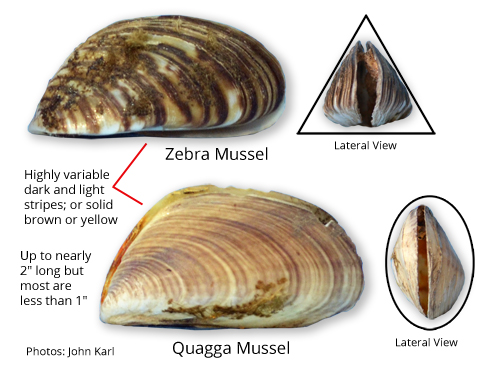

As water-based recreation grows in popularity and invasive species become more common, it's critical that paddlers take an active role in protecting our waterways from aquatic invasive species (AIS). Mediation costs run into the hundreds of millions of dollars in the US each year and can devastate lakes, streams, and rivers. Spread the word on AIS prevention, not the bugs!
Aquatic Invasive Species (AIS) are exotic or non-native species that live in water, spread rapidly and pose a significant threat to aquatic resources, water supplies, and water conveyance infrastructure.
These species cause significant environmental harm to other native wildlife and limit uses of natural resources. Prevention, early detection, and rapid response are the most effective and least costly approaches to controlling the spread of aquatic invasive species, since there are currently no known treatments to eradicate aquatic invasive species once they become established in a water body.

PLAN: If you're traveling with your packraft -- domestically or internationally -- take a moment to read up on Aquatic Invasive Species risks in the water you are paddling now, and where you will be going next.
CLEAN: Rinse off any mud, debris, and vegetation with a big sponge before you leave the river. Inspect your packraft, paddle, booties, gloves, wet/ dry suit, etc. to make sure nothing is hiding in the crevices and seams. Use a brush on your shoes.
DRAIN: Once you are on shore, disassemble your spray skirt hoop, seat, open any zippers, and shake out your boat. Wipe everything down with a towel, working it into the joints where the floor and deck meet the tubes to remove any pooled water.
DRY: At camp and at home, inflate your boat and hang your gear to dry. Drying time varies by temperature and humidity, but greater than 48hrs is a good target. During this time, run a towel about to ferret out any remaining water.


If you can't dry your gear, soak it in hot water. Most aquatic invasive species will be killed by 5 minutes in a 120oF bath. (120oF is nearly too hot to touch, typically the temperature of hot water directly out of the tap. Note, car washes are not hot enough.)
Just 15 seconds in 140oF water is equally effective, but will scald your skin, and laminated gear such as Gore-Tex dry suits should not be exposed to water this hot. Check the water temperature carefully with a thermometer.
No hot water at camp? Find a boat inspection and decontamination station by calling the local land/water agency (e.g. State DNR, Forest Service, BLM) or an angler’s shop.
If you can't dry out your gear between trips and soaking it in hot water isn't an option, leave your packraft behind and go for a hike. Don’t be a vector for aquatic invasive species!
The packrafting pulse, in your inbox.
Subscribe to Our Newsletter